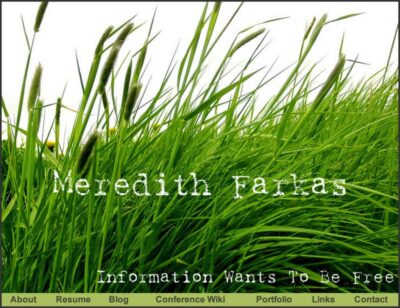It’s pretty clear from the comments on my recent posts that many of us have a sense that the sort of information literacy instruction we’re providing is not having the impact we’d like. But even when we know that what we are doing isn’t a right fit, it can be difficult to try something new. Frequently the limitations are bodies; most libraries simply don’t have enough librarians to do high-touch instruction throughout the curriculum. How many libraries are doing embedded projects as the norm rather than an exception (i.e. only in a few classes)? How many have the staffing for embedded librarians in every core class that requires research? Then there are the expectations of disciplinary faculty, some of whom may be open to new instructional models and some of whom would not. Then there are the expectations of administrators who may not be comfortable with the library taking instructional risks at a time when demonstrating how the library contributes to student success is critical. And then there’s us. It’s far easier to know what’s not working than to know what will. I’ve tried things with instruction that have failed and others that have succeeded brilliantly, and never did I know for sure beforehand which was which. And, especially for someone on the tenure track, that’s pretty freaking scary.
This Fall, we will be trying a new model of information literacy instruction to first-year students. Our University has a model for freshman instruction (a year-long program called “Freshman Inquiry”) that has been has been lauded nationally and replicated at other institutions. While the model for Freshman inquiry was very different than what many institutions were doing, we were still doing instruction very similarly to how the vast majority of librarians do it: through the one-shot. Don’t get me wrong, many of us had embraced a constructivist pedagogy, incorporated active learning exercises, and focused on teaching skills over tools. We’d certainly transformed those aspects of teaching. But we were still using the inoculation approach; teaching information literacy in a one-shot (or occasionally a two-shot or three-shot) and hoping it would take.
Especially with Freshman, I suspect it doesn’t take. First of all, this is a group that has been shown in the literature to greatly overestimate its skills in searching and finding information. So most probably don’t see the value of what they are learning in a “library session.” Second of all, the librarian is coming into the class essentially as a stranger. If this content was so important, why wouldn’t their instructor or peer mentor (sort of like a TA; an upper-division student who supports the student’s learning throughout the year) teach it? Thirdly, because we only come into the class one time, we can’t scaffold their learning and have to throw out a lot of stuff that they might not immediately use because of the timing. Finally, these students are having a lot of information thrown at them at once. When they are assigned that first research paper of their college careers, they likely need to develop skills not only in searching for and evaluating information, but also figuring out what they’re looking for, where to look, how to read those texts, how to synthesize the main ideas from those texts, and how to incorporate what they’ve learned into a paper. Oh yeah, and how to write. It’s a tall order and I’ve mentioned in the past my dislike of the Freshman research paper; especially those that require using peer-reviewed sources. But I can’t change the way research is assigned by a large group of autonomous instructors (many of whom are tenured faculty in other departments).
What I can do, though, is change the way we teach in response to these realities. Seeing a student once or twice during the year simply doesn’t seem like the best way to teach students to be effective seekers and users of information. And given the size of our school and our current staffing, there is no way for us to do more teaching to Freshman without seriously hampering the strong program of discipline-focused instruction we have. And at an institution where 2/3 of students come in as Juniors, that seems wrong-headed. Our ace in the hole is the fact that there is a peer mentor in every class; an upperclassmen who works with students each week for an entire academic year, supporting their learning and success in the class. In addition to class-time with the instructor, each student has a weekly mentor session in smaller groups. Given their relationship with Freshman, these mentors seem like the best-positioned to provide information literacy instruction in a scaffolded way, providing instruction on specific elements of information literacy at a time when students can use it in practice.
So part of our new model involves taking a train the trainers approach. We will support the mentors in providing information literacy instruction. The mentors might be more knowledgeable than Freshman, but they’re still Juniors and Seniors, many of whom may not have great information literacy skills themselves. This summer, we’re creating online learning objects tied to specific learning outcomes. The learning objects are short and modular and can be combined in various ways to meet the unique needs of each class. With each learning outcome, we include suggested activities and assignments that can assess whether students understand how to apply what they’ve learned in that area. For example, in the area of developing a search strategy, I developed three in-class activities and two worksheets that could be assigned as homework. Essentially, this is library instruction in a box, but a box that can be readily customized for each class. In addition to providing these learning objects and activities, we’re also going to support the mentors through training and through working individually with a librarian. Each librarian will be assigned to specific Freshman Inquiry classes and will work with the mentor to create a customized online course guide for the class and a plan for information literacy instruction. Obviously our success in this area will depend largely on the mentor and the instructor, so we will be involved with the faculty retreat and mentor trainings before the start of Fall term.
We also still want the students to know that the library is here to help them. I can’t tell you how many times I’ve heard librarians say (with regard to their sessions with lower-division students) that “if nothing else, at least they learned that librarians are here to help them.” If that’s all we hope to accomplish, why use an hour or more of class time for it? We plan to do what we’re calling a “Constance Mellon warmth session;” a 10-15 minute session in the students’ classroom where we introduce ourselves and how we can support students with their research (reference help, research guides, etc.). And if faculty still want their students to get into the library, members of Public Access Services offer library tours twice per week. I’ve never really understood the whole “get them into the library” concept when we usually just stick them in a computer/learning lab for the entire session. Unless they’re doing some sort of orientation or tour or activity that gets them going around and using the library, I’m not sure that the location thing is really that meaningful. In fact, my theory is that putting them in a classroom that is not their own (that they may never have been in before) probably makes them less comfortable in the session, which probably interferes with learning (though we’re usually doing it because their classrooms don’t have computers, which is probably more important than comfort). Has anyone done research on the impact being in a foreign environment (different classroom) has on learning and/or cognitive load?
Also, late in each quarter (in the few weeks before papers are usually due), we’re going to offer drop-in research clinics where Freshman Inquiry students can come in and work with a librarian on their specific research topic. These are designed for those students who realize that they’re in over their head and want support. I doubt we’ll get that many students coming to this, but I do think it’s worth offering and marketing to every class. It puts control over learning squarely in the student’s hands, and I believe this kind of autonomy is critical for developing information and help-seeking skills that will help them succeed in the real world.
We’ll be assessing the efficacy of this model. The University Studies program already does a major assessment each summer of student portfolios, so we plan to develop an information literacy rubric and compare portfolios from this past year to next year’s. Hopefully we’ll see a positive difference, but who knows? We also hope to be able to administer some mini-assessments throughout the year through the mentors (though we don’t want to kill them with questions). It would have been nice if we’d done this at the end of the school year that just concluded, but the planning for all this happened rather quickly (isn’t that how these things tend to go?). We’ll also certainly survey the faculty and mentors involved in Freshman Inquiry to determine how we can better support them the following year.
Some might believe that this model will require less of a time commitment to implement than doing one-shots, but I believe it will require more, and that’s not even including the tremendous amount of time that I and two colleagues are spending on developing the learning objects this summer. This requires working more proactively with the mentor and/or instructor and supporting someone who has never taught information literacy to others. While there isn’t the same sort of lesson prep and specific times won’t need to be blocked out of one’s calendar as often, it’s still going to be quite a time commitment. And I think the first year will be the toughest because we have some faculty we’ve never worked with and others who have come to expect a certain type of library involvement in the class. We’re not the only ones who have seen the library one-shot as a given in Freshman instruction.
I’m very excited and nervous about this change. It’s a major change with a lot of moving parts. If the librarians involved on the Freshman Inquiry Team are not proactive with their instructors and mentors, we could fail. If the mentors are not responsive, we could fail. If our learning object and activities are boring, we could fail. And on and on. And while this was a strategy the instruction team came up with as a whole, I’m the one who championed it to administration in the library and to University Studies and I fear that I will bear the blame if it doesn’t go well. I feel confident that we are on the right track with this change, but I’m sure this first year will not go perfectly and we will need to retool and improve based on what we learn from the assessment work. But I’m glad we’re doing something and not just sticking with the devil we know because it doesn’t require such risk. If nothing else, we will learn a lot from this experience that will help us to develop a better experience the next year. Continuing to do the same-old-same-old will not achieve that.




>> I can’t tell you how many times I’ve heard librarians say (with regard to their sessions with lower-division students) that “if nothing else, at least they learned that librarians are here to help them.” If that’s all we hope to accomplish, why use an hour or more of class time for it? We plan to do what we’re calling a “Constance Mellon warmth session;” a 10-15 minute session in the students’ classroom where we introduce ourselves and how we can support students with their research (reference help, research guides, etc.). And if faculty still want their students to get into the library, members of Public Access Services offer library tours twice per week. I’ve never really understood the whole “get them into the library” concept when we usually just stick them in a computer/learning lab for the entire session. Unless they’re doing some sort of orientation or tour or activity that gets them going around and using the library, I’m not sure that the location thing is really that meaningful.<<
I couldn`t agree more. In many cases I think the traditional library orientation tour causes more harm than good, because it ruins the image of what a library really is.
Your thoughts on instruction are very interesting. I have spent a lot of time these last few years trying to come up with an instruction program that I believe in (pedagogically) and that, at the same time, is doable. It is not an easy task. Thank you for sharing your ideas here.
Pingback: The devil you know in first-year instruction | Information Wants To Be Free | academic library | Scoop.it
Pingback: The devil you know in first-year instruction | Information Wants To Be ... | Library instruction | Scoop.it
Meredith,
I can’t applaud your efforts, your courage, your team’s commitment to a new plan, enough. Seriously. What you guys are doing, what you’re championing is a big deal. We see it everyday, it’s easy to live with the devil you know, even knowing how far short it falls. You will succeed and you will succeed by learning from the failures 🙂
@Karen, good for you for working through the inertia that keeps us doing things we know aren’t working. It must feel good to do something you really believe in.
@Karl – thank you! We’re really excited to try it out and fully view it as a pilot that we are going to have to tweak over the months and years to make it a really great program. I think a lot of people are paralyzed by the notion that whatever change they create has to work perfectly out of the starting gate, and that’s just not realistic.
At our two urban centers with lots of pt faculty, we invite ourselves into their classrooms for a “hi, I’m here” session. This leads to workshops, 1:1 requests, tutoring, returns to classroom as well as traditional info lit sessions in a lab. We need to assess beyond formal instruction work to see that the continuing exposure and support is there in a variety of ways. But your peer-tutor idea is a great addition.
Pingback: A New Approach to Freshman Info Lit | Librarian Squared
Meredith,
I really like what you are doing here. I can’t wait to see how it goes!
One thing that struck me about your model is the mentors: Helping freshman learn effective searching and information literacy skills will help the mentors learn them as well. Nice!
Pingback: The devil you know in first-year instruction | Information Wants To Be Free | Teaching & learning in the creative industries | Scoop.it
Exactly, Sarah! Not all of the mentors are expert researchers themselves, so this helps get them all on the same page too. And learning is always stickier when you have to teach it.
To your question “Has anyone done research on the impact being in a foreign environment (different classroom) has on learning and/or cognitive load?” — There was a fascinating presentation at ACRL 2011 called “Opening Pandora’s Stream: Piping Music into the Information Literacy Classroom” that partially addressed what I think you’re wondering about. More information is here:
http://works.bepress.com/dianna_sachs/7/
Awesome! Thanks for sharing this Olivia! I’ve been wanting to do a lit search on it, but this will give me a head start!
Meredith,
This is a great effort. Just getting everyone to agree to embrace the change can be a daunting task!
My institution recently adopted a class similar to your freshman inquiry program (called Critical Inquiry here) and I was tasked with developing an assessment rubric for the student portfolios. I actually found the Information Literacy Value Rubric from AAC&U to be extremely helpful. I thought you and your other readers might be interested. The rubric is found at: http://www.aacu.org/value/rubrics/pdf/InformationLiteracy.pdf
Pingback: Just Subscribe | Librarian Squared
Pingback: Of learning theories and Learning 2.0 at TransTech: Live to Learn
Pingback: The devil you know in first-year instruction | Information Wants To Be ... | at school libraries | Scoop.it
Pingback: Bonus Post: Bloggers in LibraryLand « Leafing Light
Pingback: Our new model for Freshman instruction and how it went | Information Wants To Be Free